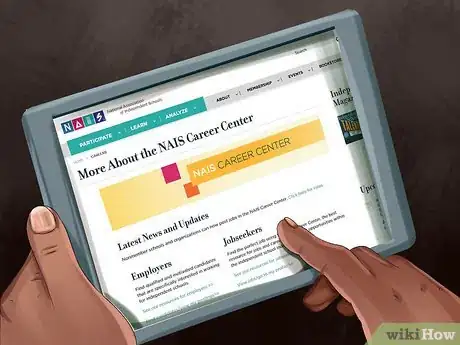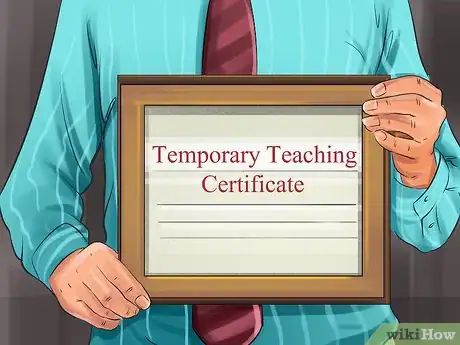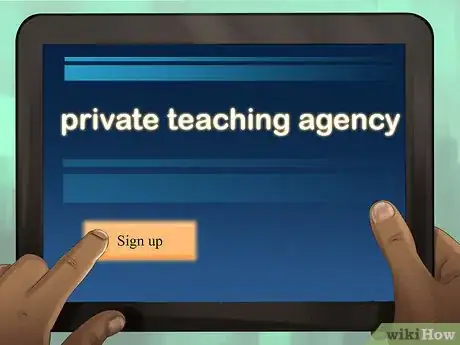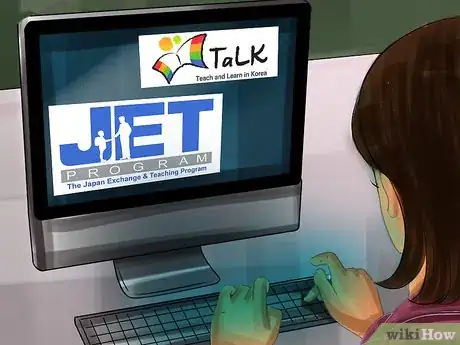This article was co-authored by wikiHow Staff. Our trained team of editors and researchers validate articles for accuracy and comprehensiveness. wikiHow's Content Management Team carefully monitors the work from our editorial staff to ensure that each article is backed by trusted research and meets our high quality standards.
There are 9 references cited in this article, which can be found at the bottom of the page.
This article has been viewed 22,239 times.
Learn more...
Getting an education degree is far from the only way to start teaching. If you decided late to enter the career, or are just interested in taking a more individual path, you have options. Teaching in private schools, as a substitute, or with special programs like Teach for America allows you to work in a traditional institution. You could find alternative teaching opportunities as a corporate trainer, community educator, or TESOL/TEFL teacher. And if you're ready for a real adventure, there are plenty of chances to teach abroad.
Steps
Finding Alternative Ways to Teach in Schools
-
1Teach at a private school if you have another type of degree. Look for postings for jobs at private schools and online through the websites of organizations like the National Association of Independent Schools (NAIS). In many cases you don't need a degree in education. Instead, a bachelor's degree or higher in a subject area (like English, Biology, or Italian) can be enough.[1]
- Job postings will generally be tied to the school calendar. For instance, there might be more openings in the spring or summer, before the start of a school year.
- Some private schools will want their teachers to have a Master's degree or higher.
-
2Substitute teach to see if teaching is the career for you. Contact your local school district and let them know you're interested in substituting. As long as you have basic qualifications, such as a bachelor's degree, many will allow you to sign up to be on a list of potential substitute teachers.
- The pay is often low, however, and you can't plan on when you will be hired to work, or for how long.
Advertisement -
3Look for special programs that hire recent college students. Ask your school's career office about nontraditional teaching programs. People with expertise in areas like mathematics, science, or computer science are highly sought, but many programs are open to students with degrees in any area. For example:[2]
- Teach for America seeks recent college graduates to teach in underserved schools, even if they don't have an education degree.
- Teach for All is a similar program that places people in schools around the world.
-
4Work in a location where you don't need an education degree to teach. Ask your local school district if there are alternative paths to teaching there. Some areas, like the state of Utah, have such a shortage of teachers that they no longer require a degree in education. Instead if you have a college degree, and can pass certain qualifying tests, you are eligible for the job.[3]
- Similarly, in Wisconsin, you can teach certain vocational and professional subjects without a degree in education.[4]
-
5Get temporary teaching certification. In other areas, if you plan to become a teacher you can start teaching even before you have your complete credentials. In these locations, you can get a temporary certificate if you have a bachelor's degree. However, you must enroll in an approved program and earn your full certificate in a certain amount of time.[5]
- Teacher prep programs are available to help people who want to get a full teaching certificate after already completing an undergraduate degree in a non-education area. Check with your local school district or college or university for details.
Teaching Outside of Traditional Schools
-
1Teach English as a second language (TESOL) or as a foreign language (TEFL). TESOL and TEFL teachers are in high demand in areas where immigration rates are high or cultures are very diverse. You don't have to get a degree in education, only a certification in TESOL or TEFL. Many colleges and universities have separate certificate programs to help you earn these in 6 months to a year.[6]
- You will enroll in a series of courses on theories of teaching English as a second language, on working with adults or children, and similar subjects. You will also complete a period of student teaching.
- Tuition costs will vary depending on the school. Sticking to public schools or online programs may help keep the costs down.
-
2Adjunct at a local college if you have an advanced degree or expertise. Most colleges and universities now hire numerous adjuncts to teach all sorts of classes. In many cases, a Master's degree or significant work experience in the area you want to teach is all you need. The pay is usually low, and you will probably only be hired on a per-semester basis. However, if you're just looking for some teaching experience, this can be a way in.
- Often, you can just go straight to your local college and let them know you'd like to adjunct. If you're qualified they'll add you to a pool of potential candidates who might be hired when there is need.
- Other times, you will need to check the college's jobs page and follow the application instructions.
- There are an increasing number of online adjunct teaching positions with colleges and universities as well.
-
3Become a corporate trainer. Businesses host workshops and have training sessions all the time. In many cases, what they really need is someone with enthusiasm and good communication skills to lead those sessions, even if they're not an expert in business. If you have an outgoing personality and believe you can teach anyone anything, this could be a great alternative teaching route for you.
- Businesses might ask you to lead workshops in areas like "Effective interpersonal communication," or "Defining your leadership goals."
- A degree or some training in counseling, communication, or a similar area will help. Experience (tutoring, volunteering, etc.) showing your ability to communicate and explain information effectively is a plus.
- You may see job postings from companies seeking to hire corporate trainers. More likely, you'll have to start your own business and try to seek clients through networking.
-
4Lead adult education classes. Talk to your local library, community college, vocational school, continuing education center, or community center. They're often very interested in having people lead workshops or teach short term classes to the community. If you are a self-starter and have an idea you'd like to run with, give this one a shot! Depending on your interests and experience, you could teach things like:
- A basic Spanish class
- An intro to computers class
- A conversational English class for non-native speakers
- A class on the history of your area
- After-school math tutoring
Teaching English Abroad
-
1Sign up with a private teaching agency. Do a quick Internet search for agencies that hire people to teach English abroad. While you can do all of the prep work yourself, going through an agency will make it much easier to arrange things like visas, housing, and travel. A certificate in Teaching English as a Foreign Language (TEFL) can be helpful, but it's often not necessary. Areas with a high demand for native English speakers to teach include:[7]
- South and Central America (Argentina, Nicaragua, etc.)
- Asia (Cambodia, Thailand, etc.)
- Russia
- Europe (Spain, for instance).
-
2Sign up for an exchange program. If you're a current college student or recent graduate, get in touch with your school's study abroad or international education office. There are several well-established programs to choose from, like Teach and Learn in Korea (TALK) for South Korea and the Japan Exchange and Teaching (JET) program. They're a great way to get some experience abroad and share your knowledge base.[8]
- For example, the JET program has Assistant Language Teachers (ALTs), Sports Education Advisors (SEAs) and other positions.
-
3Get a Fulbright grant. Check the Fulbright agency's website and with your college (if applicable) for application details. Some Fulbright grants are awarded to people with bachelor's degrees to teach English abroad.[9]
- These grants are competitive. For your application, you will likely have to write a statement of interest, get letters of recommendation, and complete interviews.
- Other Fulbright grants are given to non-Americans to give them experience teaching or researching in the United States.
References
- ↑ https://learn.org/articles/What_Are_the_Requirements_to_Become_a_Private_School_Teacher.html
- ↑ https://www.teachforamerica.org/join-tfa
- ↑ http://blogs.edweek.org/teachers/teaching_now/2016/06/teaching_degree_utah.html
- ↑ https://dpi.wi.gov/tepdl/pathways/experience-based-technical-vocational-subjects
- ↑ http://www.fldoe.org/teaching/certification/pathways-routes/teaching-for-the-career-changer-or-col.stml
- ↑ http://www.tesol.org/attend-and-learn/certificate-leadership-programs/tesol-core-certificate-program
- ↑ https://www.internationalteflacademy.com/blog/bid/74176/no-degree-no-problem-the-6-best-countries-to-teach-english-without-a-college-degree
- ↑ https://www.gooverseas.com/blog/teach-english-abroad-without-degree
- ↑ https://us.fulbrightonline.org/about/types-of-awards







































































